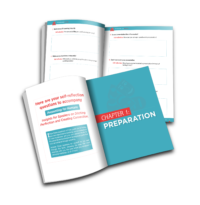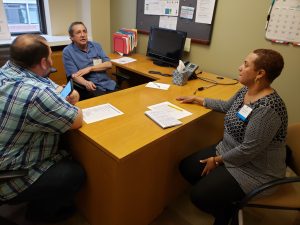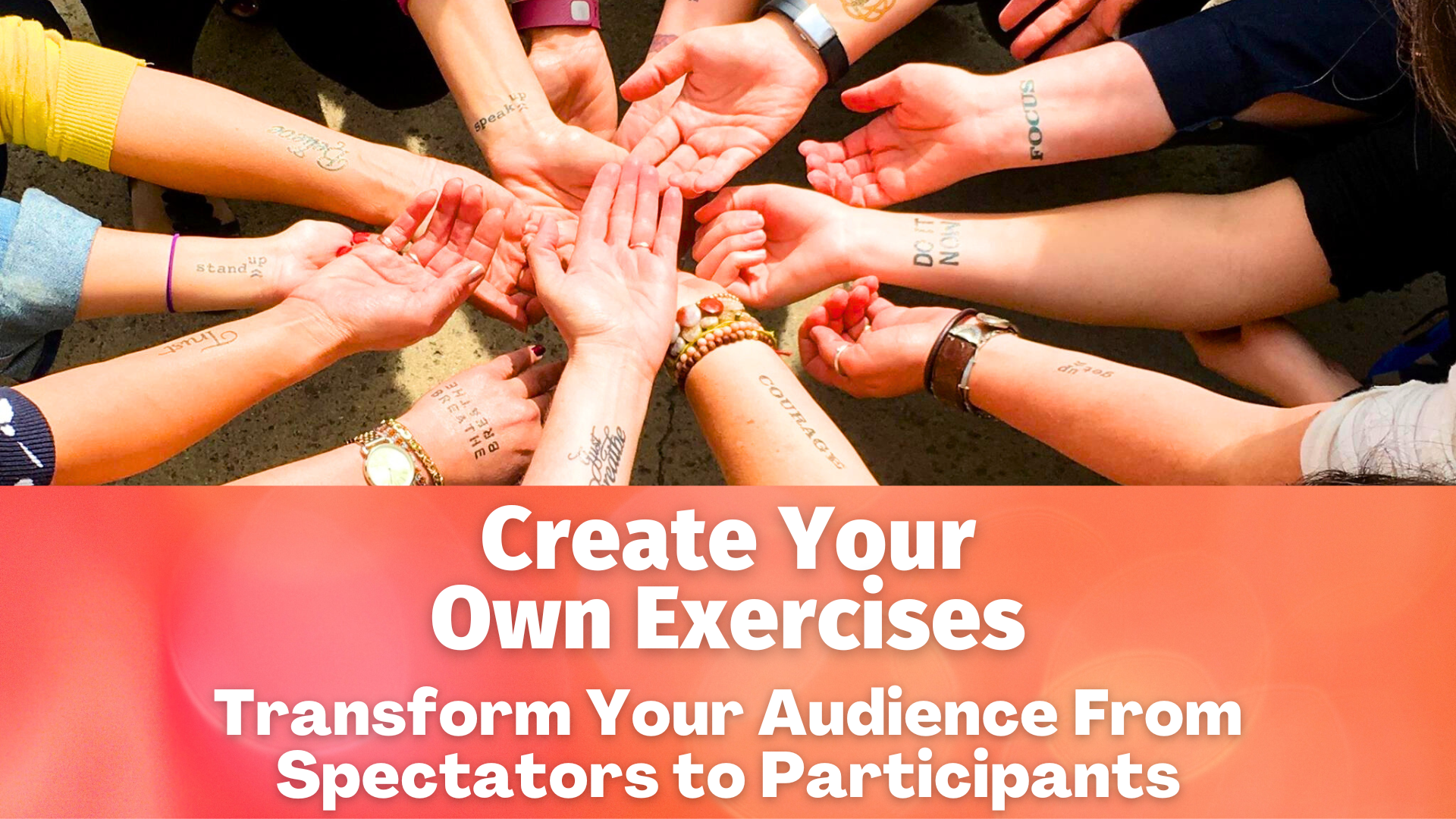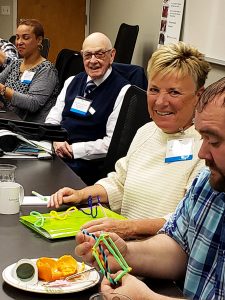
Stand out from other speakers in your field... engage your audiences... deliver unique experiences
Grab my simple framework for creating your own interactive exercises and 10X the impact of your presentations (yes, virtually, too!)
You're a business or nonprofit leader, you're a thought leader and a change maker, and speaking is a primary tool for you to get your message and work out to the world.
You've heard that audience engagement is critical if you want your audiences to take away meaningful learning from your presentations, and especially critical if you want them to take meaningful action.
You hear that stories, activities, questions, demos, group work and other tools are the ways you can achieve audience engagement.
But where do you get the stories?
How do you come up with the activities, the questions, and the demonstrations?
And how do you ensure that these activities are congruent with the message and results you want your audience to take away?
🤔🤔🤔
Sure, you can look these up online or ask your colleagues what they're doing, but then you're copying someone else's activities. They're not your own.
And your audience has probably done these same exercises dozens of times, because everyone else is using the same online sources!

Like any other expert or authority, you want your materials and methods to match your intellectual property, not be a copy of someone else's work.
You want your presentations to uniquely express your message in your own unique voice and personality, and you want practical and engaging activities that follow suit.
And, ultimately, you want your presentations to be memorable and meaningful, so you fully connect with your audiences, you offer the learning, growth and transformation they're looking for, and you get the results you want: More clients, customers, donors, volunteers or supporters.
 It's not necessarily wrong to adapt another person's activity to your own style. It's so easy to make your own, though, it's really a no-brainer!
It's not necessarily wrong to adapt another person's activity to your own style. It's so easy to make your own, though, it's really a no-brainer!
But maybe you lack the knowledge and experience to develop your own. After all, you haven't spent the last 20+ years developing training tools.
But I have!
In 1994, I received my master's degree in Education. During that time, I was working with children and youth in a domestic violence organization.
Part of my job required me to go into local high schools and teach teenagers how to identify healthy and abusive relationships.
I was extremely intimidated about going into high school classrooms, with this presentation outline in hand that someone else had created.
After all, I had once been a teenager, and I knew how ruthless they could be!
So I started integrating my grad school learning into my high school presentations, and this became the testing ground for my own experiments in engagement and interaction!
I learned so many things from working with youth over the next eight years, but one of the most useful was how to create exercises and activities to illustrate the concepts I was teaching, to make the material resonate in as many ways as possible.

I started out using existing materials and adapting them to my own uses, and soon was able to start creating my own activities from scratch. And I took this with me to every new organization I worked with.
From helping the children in the shelter get in touch with their bodies and emotions (anyone remember Slim Goodbody?), to exercises with junior high school students about effective communication, to activities helping young women learn about healthy eating and exploring new foods, in each new position I would come up with new ideas.
I helped my students and participants learn more effectively, through writing, drawing, movement, exploration and discussion.
Now, with more than 32 years of teaching and training youth and adults, developing my own activities and exercises, guess what I recently realized:
Not everyone knows how to do this!
I've been asked repeatedly by colleagues and by clients for help with creating activities for audience interaction and engagement.
Finally, it occurred to me that this is something I should be teaching as a course, not just offering behind the scenes with 1:1 private clients.
So I deconstructed my process for creating exercises to bring you this virtual training:

"Lisa, I just wanted to thank you for your fabulous webinar on engagement!! It was outstanding! I bought a wheel of fortune because of you! I have zero clue how I’m going to use it, but I’m excited to figure that out!!"
Cheryl Leighton Knowlton
When you give your audience the opportunity to approach your concepts through different modalities of learning, you give them the opportunity to learn in the ways that work best for them.
✏️You might have people in the room who like to write their thoughts on worksheets or in journals.
🗣️You might have people who need to discuss ideas out loud to make sense of them (that's me).
💃You might have people who like to physically move around the room.
Please note: I'm not talking about the outdated concept of "learning styles" where we used to lump people into boxes of "visual," "auditory," and "kinesthetic." Humans are much more complex than that, and we don't fit into tidy learning boxes.
outdated concept of "learning styles" where we used to lump people into boxes of "visual," "auditory," and "kinesthetic." Humans are much more complex than that, and we don't fit into tidy learning boxes.
We're all individuals, and the more you can approach your audience from this place—that everyone has different and multiple ways they learn best—you can really start moving them and challenging them and helping them grow.
"My Conflict Roundup seminar was over. Participants were enthusiastic. Organizer was delighted. And, I thought to myself, 'I can do better!'
Two days later I signed up for Coach Lisa’s engaging and informative 'Create Your Own Exercises' webinar. Great insights—and a powerful framework for developing new, interactive learning exercises IN MINUTES.
Next, I tapped into one-on-one coaching, so I could apply Coach Lisa B’s framework to my Conflict Roundup seminar.
The end results: Existing activities totally refreshed. More learning exercises to draw from, when needed. All activities will reinforce key seminar takeaways. Yippee!!"
Jeri Mae Rowley
What you'll learn:
💡Why audience participation is important
💡What are some specific needs of adult learners
💡What we have to consider when creating exercises and activities
💡Which components you can choose from to create your exercises
💡And how you can easily put them together
What you'll get:

📝Create Your Own Exercises virtual training
📝Create Your Own Exercises PDF workbook to follow along with the webinar and design your exercises as you watch
📝Deconstructing Your Exercises Reference Guide Video, where I show you exactly how I've created four of my best presentation activities (and a fifth that I eventually threw away - and I'll explain why!)
📝PDF guide to deconstructing your exercises to work through with the video
"You are such a pro. And your style feels like classic California: laidback, relaxed, kind, super friendly. You took care of us on the call.
I loved the reinforcement that what I'm doing is right on-target. Will have 3-person small groups do some practice. Also like the features/benefits practice with the photo images of random stuff!
Really well-done, Lisa! Thank you.
Diane Ripstein
"I got so much out of going through this training, it really kick started some great ideas for interactive activities. I highly recommend it!"
Kali Williams
You'll come away from this training with the tools—and confidence—you need to create engaging and interactive activities that make your presentations more effective, more compelling, and ultimately, more uniquely YOU!
"Just when I was beginning to give up after seeing one horrible online presentation after another, you showed it could be done and done well.
Plus interactive — which is the hardest thing for an inexperienced speaker to figure out. Great lessons. I will not steal but will learn."
Tom Nixon, Presentation Designer and Coach

